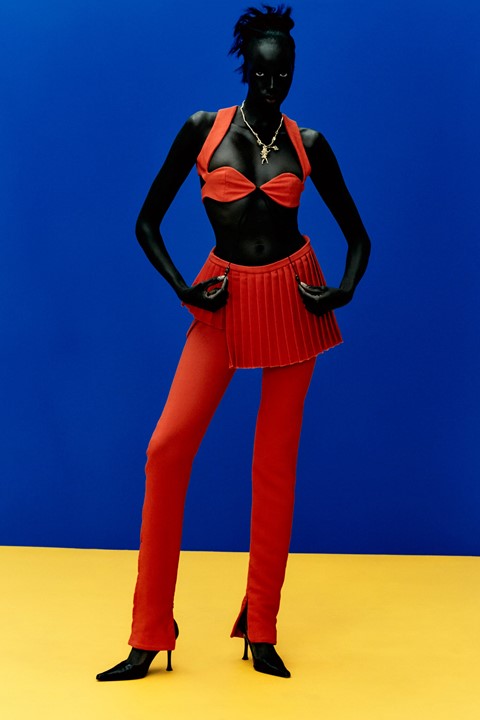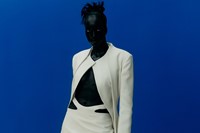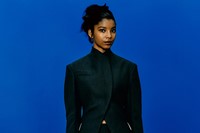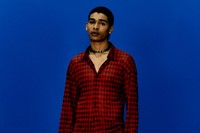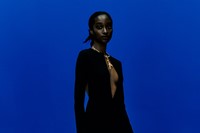“I wanted it to feel a lot more summery and have this elegance but this sexiness that I feel is carried in Trinidad,” says Maximilian Davis of his first collection, shown as part of Fashion East
There is something brewing and there has been for some time: a bubbling undercurrent of fresh British talent, leading the charge towards new perspectives and necessary change. Often birthed by the communities fostered by club nights like east London’s PDA, these creatives often rub shoulders on set as much as they do on the dancefloor – the kind that designer Maximilian Davis reimagined in his short film debuted this past London Fashion Week, in lieu of a physical runway show. Davis, who is no stranger to this emerging new wave, exudes its energy and enlisted a wealth of his peers from within this scene to launch his first collection under Fashion East. A mere taste of what its infectious spirit has to offer.
Captured in beautiful imagery shot by Rafael Pavarotti and styled by Ibrahim Kamara, the collection is an exploration of his Trinidadian roots and culture, the origins of its carnival or ‘canboulay’ – a late 18th- and early 19th-century counteraction to slave owners’ masquerades which excluded slaves – and works by the likes of Agostino Brunias whose 18th-century portraiture depicted West Indian life and its evolving Creole cultures. Picture calf-suede shredded mini dresses with asymmetric straps, clean-cut tailored dress coats with layered detailing, and a long-sleeved gown with a backless cut-out detailing resembling the highways of Trinidad he’d ride around in a taxi.
A week after his well-received debut, I spoke with Davis about the importance of community, West Indian ease, and what we’re to expect from him in the future.
Kacion Mayers: How did this all begin?
Maximilian Davis: I used to work for Wales Bonner, designing tailoring, commercial pieces and knitwear, and then my grandmother passed away while I was working there. Literally, just before a show. It kind of made me feel like I didn’t want to do fashion in that moment and so I took some time out. After about nine months, I decided I wanted to get back into fashion and I felt like I wanted to make a collection that was more personal and which meant something to me. The one thing that I wanted to do was something related to my grandmother.
KM: How did carnival become such a lead in this collection?
MD: One thing that was apparent once I started to look into her heritage and background was carnival and her love of music. That was one thing that got my family and the different sides of the family together. She’s from Trinidad, and she moved over to the UK to be a nurse. The names of the garments also have something to do with Trinidad: so the ‘Narisha’ mini takes its name from my cousin, the ‘Maracas’ swimsuit from a beach in Trinidad, and the ‘Palm’ suede cut-out dress is inspired by palm fronds. Everything is related. Even the ‘Highway’ gown, which I named because of its back which reminds me of travelling around in a taxi on the highways of Trinidad.
KM: And you’ve mentioned this sense of ‘Caribbean ease’ which I can relate to. Could you describe that for me from your own perspective?
MD: The ease is just the way that my grandmother would dress and all the females would dress when I am over there. It’s about putting whatever you have on, and making it work. You want to be free and that celebration of freedom but translating that through the clothing and the way that they dress. Because that brings out the confidence and the sexiness that … the perfect word is ‘ease’. It is what it is, there is no stress. That’s something that my grandmother and my family have always taught me. Don’t stress about it, it will happen.
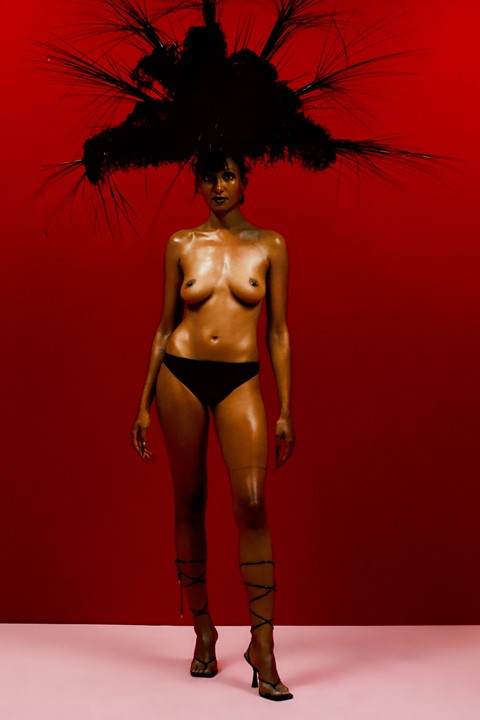
KM: Were there any other key points of reference?
MD: Watching loads of Beenie Man videos and Sean Paul videos. One of my biggest references for this collection was Sean Paul’s I’m Still In Love (With You) video. There is an activist called Jean-Baptiste Belley and what I liked was the elegance in the portraits that I had found of him. There’s also an artist called Agostino Brunias who painted the women of the West Indies. It was really nice to see the women and what they were doing in the 18th century, the colours that he would use and the elegance and purity that translated through the paintings. It kind of set the mood. Also, with the blue devils, that captured the essence of this dark mood that I wanted in the collection. Even though the collection is colourful, it still has a darkness and mysteriousness about it.
KM: How important is community and building that network of like-minded individuals?
MD: As a new designer and a young designer, it’s important to build a community around you because these people are the next generation and these are the people that you are going to come up with. I think me working with my friends and people that I adore, it creates imagery like this, it creates work like this, you can see the love and the passion in this throughout. Right down to the hair, the jewellery, everything. Everyone really came together and having that community is really important so try and hold on to your friends for as long as possible.
KM: How have your relationships with the likes of Mowalola and Grace Wales Bonner helped you define who you are in your collections? What have they taught you?
MD: Mowa is one of my best friends and working with her has taught me that you can do whatever you want. Don’t be afraid to be yourself. Also, with Grace I feel like I learnt to not be afraid of who I am and my identity. Don’t be afraid to talk about your race. I think if it wasn’t for Grace, I think fashion could be a lot different right now. Especially fashion in London, I think she opened up a pathway for new designers and also for people in the industry to want to learn and talk about race. I think there needs to be a lot more designers of colour doing that and I think she has really opened up the doors for those people.

KM: What are your favourite design details and fabrications in this collection?
MD: I wanted to design products that I knew people would be able to wear and style with anything. I’ve kind of developed a unisex tailoring in the tuxedo and the high-waisted trousers. The fabrics that I liked using were bonded fabrics or double-faced fabrics. My favourite pair of tailored trousers in the collection is made from a bonded crepe. Another great technique that I really enjoyed was the harlequin-printed jeans. This was just a screen-printed technique and because we printed after making the jeans, each print would slightly vary. For this idea, it was a reference to playing Mas, getting paint thrown all over you, and your outfit becomes splattered by the paint. I didn’t want the jeans to be perfect, and that technique kind of resembled the carefree attitude of carnival and it sort of being a bit disjointed.
KM: What would be your statement of intent with this debut and do you feel like you have accomplished those intentions?
MD: That Black elegance exists and that is my message that I want people to see. Also, I don’t want people to look at it as just beautiful imagery, I want them to realise that there is a meaning behind this and there is a message.
KM: What are we to expect from you in the future?
MD: Black elegance.
